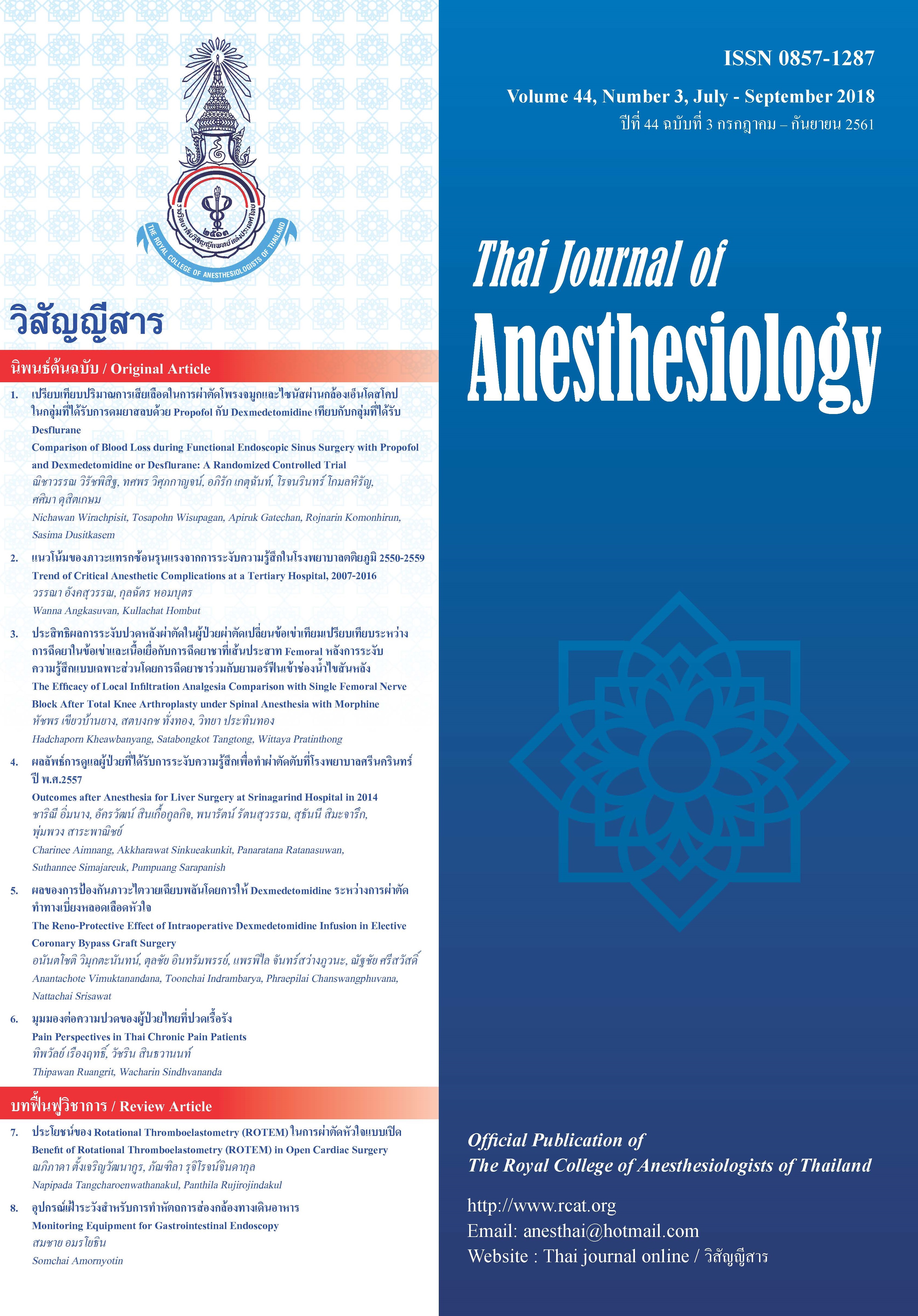Pain Perspectives in Thai Chronic Pain Patients
Main Article Content
Abstract
Background: Using a western-adapted pain interview questionnaire in Thai context leads to confusion and misunderstanding. In addition, pain experience in Thai chronic pain patients has been investigated by very few qualitative studies. This study was aimed to reveal 1) pain descriptor and 2) pain experience in Thai.
Methods: A qualitative study was conducted at King Chulalongkorn Memorial Hospital. Chronic-pain patients were purposefully invited for participation. Collecting data was by in-depth interviews guided by prepared probe questions. Content analysis was applied.
Results: Four categories were abstracted from 9 patients’ data. 1) Pain descriptor; there were unique and eccentric Thai words to represent their pain perceptions. However, serious severity of pain was described by the Thai word meant as ‘suffering’ and ‘unable to withstand’. 2) Pain resolve; all patients agreed that intravenous opioid was effective. On the contrary, they revealed ineffective pain management which caused by ordering 4-hour interval of drug administration and using pain score for assessment. 3) Adaptation; all patients have already coped with their pains. The common coping strategy was an attempt to ignore the existing pain. As a result of having free time with no pain, they had their consciences to develop their coping strategies. 4) Cultural and social involvement; common Thai culture ‘it needs to be patient with pain’ leads patients to be easily in pain acceptance phase. It was also facilitated by a medical culture of ‘pain-killer drugs are not good for health’. Thai-culture social support is an importantfactor to facilitate coping with pain.
Conclusion: Thai chronic pain patients’ descriptions of pain are eccentric and imagery. Individual interview is more effective than using structured pain questionnaire to collect information. The Thai word meant as “suffering” should be used for pain severity evaluation.
Article Details
References
2. Melzack R, Torgerson WS. On the language of pain. Anesthesiology 1971;34:50-9.
3. Melzack R. The McGill Pain Questionnaire: From description to measurement. Anesthesiology 2005;103:199-202.
4. Kitisomprayoonkul W. Thai Short-form McGill Pain Questionnaire. J Med Assoc Thai 2006;89:846-53.
5. Chaudakshetrin P. Cross-cultural adaption to the Thai language of the neuropathic pain diagnostic questionnaire. J Med Assoc Thai 2007;90:1860-5.
6. Chaudakshetrin P. Validation of the Thai version of Brief Pain Inventory (BPI-T) in cancer patients. J Med Assoc Thai 2009;92:34-40.
7. Chansirinukor W. Thai version of the Functional Rating Index for patients with back and neck pain: Part 1 Cross-cultural adaptation, reliability and validity. J Med Assoc Thai 2015;98:S97-105.
8. Bunyaratavej S. Pain. IASP(Thai chapter) Pain News 1991;2:2.
9. Niruthisard S. Pain: an overview. In: Niruthisard S, editor. Essential knowledge in pain management. Bangkok: Amarin printing & publishing Plc.; 2559. p 2-11.
10. International Association for the Study of Pain. IASP Taxonomy [Internet]. 2012 [cited 2017 Dec14]. Available from: http//www.iasp-pain.org/Taxonomy#Pain.
11. Bourke J. The art of medicine: Languages of pain. Lancet
Puttakun N. Chronic pain experience, pain management and quality of life of persons with spinal cord injury: Prince of Songkla university; 2014.
13. Patharaorn Patharakorn. Pain language: A Thai case study: University of queensland; 2010.
14. van Dijk JF, Vervoort SC, van Wijck AJ, Kalkman CJ, Schuurmans MJ. Postoperative patients’ perspectives on rating pain: A qualitative study. Int J Nurs Stud 2016;53:260-9.
15. Rosenblum A, Marsch LA, Joseph H, Portenoy RK. Opioids and the treatment of chronic pain: controversies, current status, and future directions. Exp Clin Psychopharmacol 2008;16:405-16.
16. Sturgeon JA, Zautra AJ. Resilience: a new paradigm for adaptation to chronic pain. Curr Pain Headache Rep 2010;14:105-12.
17. Esteve R, Ramirez-Maestre C, Lopez-Marinez AE. Adjustment to chronic pain: the role of pain acceptance, coping strategies, and pain-related cognitions. Ann Behav Med 2007;33:179-88.
18. Kohl A, Rief W, Glombiewski JA. Acceptance, cognitive restructuring, and distraction as coping strategies for acute pain. J Pain 2013;14:305-15.
19. Kratz AL, Davis MC, Zautra AJ. Pain acceptance moderates the relation between pain and negative affect in female osteoarthritis and fibromyalgia patients. Ann Behav Med 2007;33:291-301.
20. McCracken LM. Behavioral constituents of chronic pain acceptance: Results from factor analysis of the chronic pain acceptance questionnaire. Journal of Back and Musculoskeletal Rehabilitation 1999;13:93-100.
21.Bennett DS, Carr DB. Opiophobia as a barrier to the treatment of pain. J Pain Palliat Care Pharmacother 2002;16:105-9.
22. Krakauer EL, Nguyen TP, Husain SA, et al. Toward safe accessibility of opioid pain medicines in Vietnam and other developing countries: a balanced policy method. J Pain Symptom Manage 2015;49:916-22.
23. Hardon A, Hodgkin C, Fresle D. Sampling, sample size. How to investigate the use of medicines by consumers. Switzerland: World Health Organization and University of Amsterdam; 2004. p 57-65.


